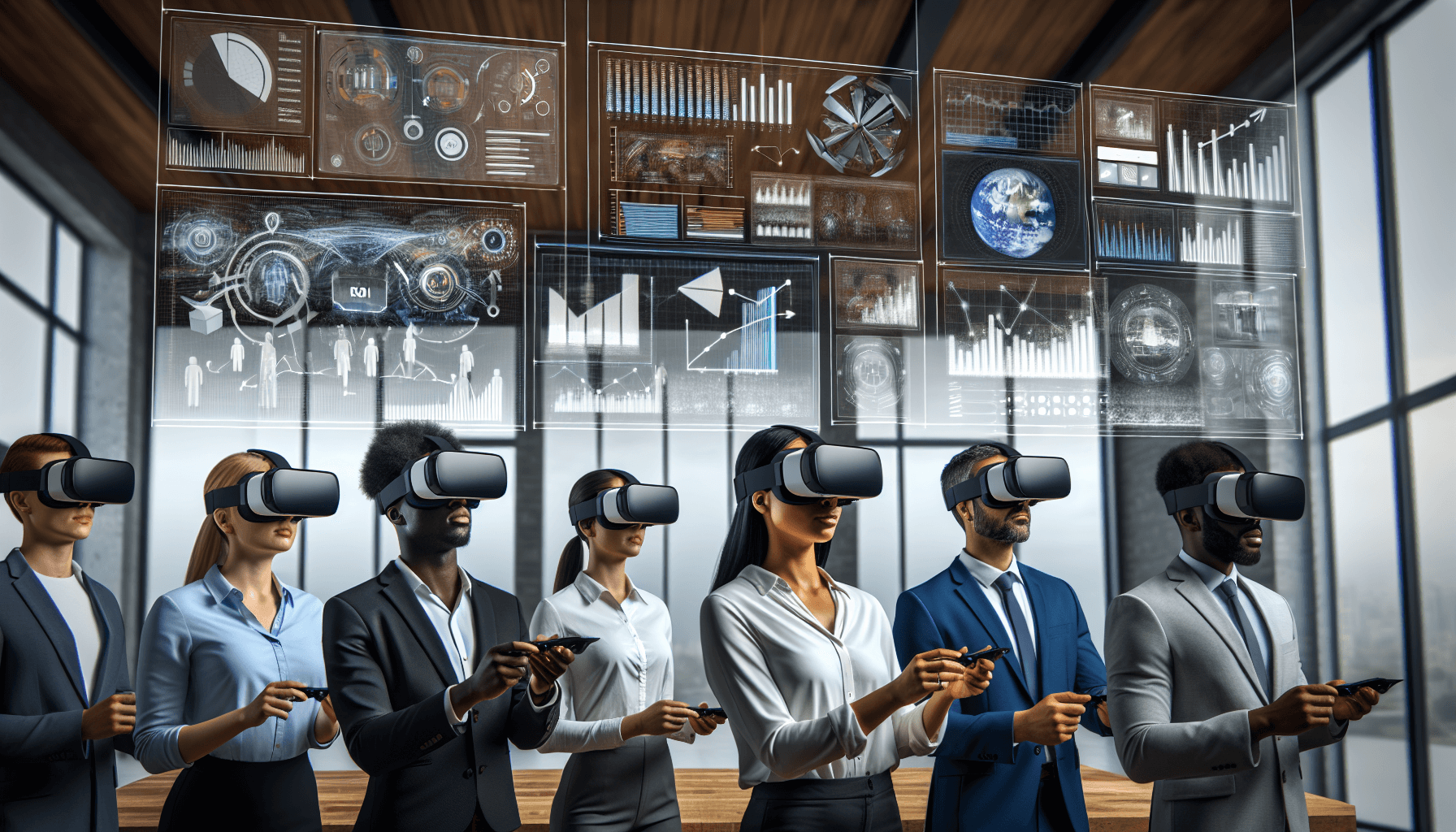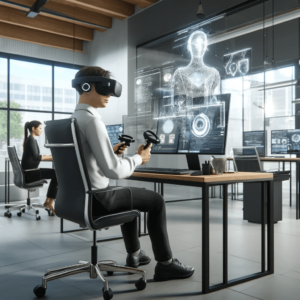In today’s fast-paced and technology-driven business landscape, organizations are constantly seeking innovative methods to enhance their return on investment while streamlining operational efficiencies. Virtual reality (VR) training has emerged as a cutting-edge solution, illustrating a paradigm shift in how training is delivered, experienced, and monetized. With its immersive simulations and scenario-based learning, VR training not only elevates training effectiveness but also significantly cuts costs associated with conventional training methodologies. This transformative approach to instructional design demonstrates how embracing VR can lead to scalable, cost-effective training solutions that have a direct impact on reducing travel, equipment, and facility costs, while also minimizing safety incidents and lost revenue due to downtime.
This article will delve into a comprehensive analysis of VR training and its cost-saving advantages over traditional training methods. We will explore the initial cost, software and hardware costs, as well as the virtual reality development cost, and juxtapose these with the traditional costs of training including travel, equipment usage, and facility rentals. Moreover, the piece will provide insights into how VR training enhances training effectiveness, promotes consistent training outcomes, and aids in better skill retention. By comparing cost comparison studies and highlighting real-world success stories, we aim to make the case for the strategic implementation of VR training within organizations looking to cut training costs while maximizing the return on investment. Through a focus on cost analysis, scalability, and the ultimate impact on organizational productivity costs, we offer a roadmap for decision-makers to embrace this innovative training modality, emphasizing the comparison of VR vs traditional training.
Cutting Training Costs with VR: An Overview
Understanding VR Training
Virtual Reality (VR) training utilizes immersive environments to simulate real-life scenarios, providing hands-on learning without the need for physical resources or risking real-world consequences. This approach integrates hardware like VR headsets and controllers, software platforms for developing training programs, and tailored content that aligns with specific training objectives. By immersing trainees in realistic scenarios, VR fosters effective skill development and engagement, illustrating what is virtual reality training and its benefits.
Comparison with Traditional Training Methods
Traditional training often involves significant expenditures on facilities, equipment, and instructor fees. In contrast, VR training eliminates these costs by allowing trainees to operate within virtual spaces, accessible from anywhere, which drastically reduces the need for travel and physical materials. Studies have shown that VR training is not only more cost-effective but also accelerates learning, with trainees completing sessions up to four times faster than traditional methods.
Initial Investment and Long-Term Savings
While the initial setup for VR training can be substantial, involving costs for hardware, software development, and content creation, the long-term benefits outweigh these upfront investments. Once established, VR training programs can be scaled with minimal additional costs, offering consistent training across various geographical locations without the recurring expenses associated with traditional methods. This scalability and the ability to conduct repetitive training without extra costs contribute significantly to its cost-effectiveness over time, which makes the VR development cost a worthwhile investment for long-term savings.
Understanding the Costs Associated with Traditional Training Methods
Travel and Equipment Costs
Organizations often face significant expenses related to travel and equipment when conducting traditional training. Travel costs for instructors and trainees to attend training facilities or work locations can quickly accumulate. Additionally, if training attempts to simulate real-world experiences, this may involve sending equipment to trainees or shutting down production equipment for training purposes, leading to lost production costs. Comparing VR vs traditional training highlights the potential savings in training personnel costs.
Facility and Personnel Expenses
The overhead costs of facilities dedicated to training and training facilities are another substantial expenditure. Some companies invest in specific facilities for training, which includes all associated overhead costs. Moreover, the cost of hiring and compensating trainers, especially external consultants for specialized training, adds to the financial burden. Implementing peer-to-peer learning can mitigate these costs by leveraging in-house expertise.
Productivity Loss During Training Periods
Training periods often result in productivity loss, as new employees may not be fully productive while acclimating to their roles. This period of reduced efficiency translates to tangible costs for the business. Additionally, the loss of productivity in having subject matter experts (SMEs) train new employees, especially if SMEs have to travel to different locations, further increases costs.
Recurring Costs for Ongoing Training
Ongoing training and development are crucial for maintaining a skilled workforce, but they also entail recurring costs. Traditional training methods require continuous investment in travel, trainers, supplies, and facility maintenance. Switching to a blended eLearning training program can reduce these costs significantly by decreasing classroom time and associated expenses, showcasing the advantages of VR vs traditional training.
By understanding these cost factors, organizations can explore alternative training methods like virtual reality (VR) training, which can offer more scalable and cost-effective solutions, addressing the overall VR training cost.
Comparing the Effectiveness of VR vs. Traditional Training
Increased Engagement and Retention Rates
Virtual reality (VR) training significantly outperforms traditional methods in engaging learners and retaining information. The immersive nature of VR captures learners’ attention more effectively, ensuring that the training material is not only absorbed but also remembered longer. Studies indicate that VR’s interactive environments lead to higher engagement levels and material retention compared to conventional training approaches.
Ability to Simulate Real-World Scenarios Safely
One of the standout features of VR training is its capacity to replicate real-world situations without any associated risks. This is particularly beneficial in industries where errors can have serious implications, such as healthcare, aviation, and manufacturing. VR allows employees to practice and hone their skills in a controlled environment, significantly reducing the likelihood of accidents or errors in real-life applications, demonstrating the effectiveness of vr training in various training scenarios.
Accessibility and Flexibility in Training Schedules
VR training offers unparalleled flexibility and accessibility, making it easier to schedule training sessions around other commitments. Unlike traditional training, which requires physical presence and often disrupts work schedules, VR training can be accessed remotely, allowing learners to engage in training at their convenience. This flexibility leads to numerous vr training benefits, like less disruption and a more efficient use of time, ultimately benefiting both the organization and its employees.
Long-Term Returns: Safety and Performance Improvements
Investing in VR training yields substantial long-term benefits, including enhanced safety and improved job performance. By allowing employees to learn from simulated accidents and refine their skills in a risk-free environment, VR training develops better decision-making abilities and minimizes mistakes. This not only creates safer workplaces but also translates into tangible savings on insurance and compensation costs. Additionally, the increased retention of information and improved on-the-job performance contribute to a company’s bottom line, showcasing VR training as a cost-effective solution with significant returns on investment.
Making the Case for VR Training in Your Organization
Assessing your training needs and potential for VR
To effectively integrate VR training within an organization, it begins with a thorough evaluation of the current training requirements. Identifying the job roles, tasks, and skills that could benefit from immersive training is crucial. This step ensures that the VR training program is tailored to meet specific organizational needs, thereby enhancing its effectiveness and value. Additionally, understanding the industry requirements and compliance standards helps in pinpointing the areas where VR onboarding could be most beneficial, focusing on the skills and knowledge employees need to master, which is essential for vr training development and initiating a successful vr pilot program.
Calculating potential cost savings and ROI
Calculating the return on investment (ROI) is a fundamental step in making the case for VR training. By analyzing the financial gains against the investments made in VR technology, organizations can evaluate the profitability of this innovative training method. The initial cost factors, such as VR equipment and software, along with the benefits, including improved knowledge retention and skill development, need to be considered. Moreover, VR training’s ability to reduce costs associated with traditional training methods, like travel expenses and venue rentals, plays a significant role in contributing to a positive ROI.
Steps to advocating for VR training implementation
- Identify Training Needs: Pinpoint specific areas where VR training can bridge skills or knowledge gaps within the organization.
- Select the Right VR Solution: Choose a VR platform or solution that aligns with your training objectives and budget, ensuring it has the essential technical features for a seamless experience.
- Create or Select Content: Develop or select VR training content that mirrors real-world scenarios relevant to your organizational goals. Tailoring the content enhances the training program’s effectiveness.
- Pilot Programs and Gather Feedback: Implement pilot programs to refine the VR training experience. Collecting feedback from participants is vital for making improvements.
- Scale Gradually and Provide Support: Roll out VR training gradually, making sure employees have access to necessary equipment and training. Offering ongoing support and continuously improving the program based on technological advancements is crucial for success.
By following these steps and conducting a comprehensive analysis of training needs, potential cost savings, and ROI, organizations can effectively advocate for the implementation of VR training to enhance learning outcomes and operational efficiency, thereby maximizing VR training ROI.
Strategic Implementation of VR Training to Cut Costs
Planning and Development
The journey of incorporating Virtual Reality (VR) into organizational training programs begins with meticulous planning and development. This phase necessitates acquiring necessary equipment and software, such as VR headsets, controllers, and platforms capable of running VR applications. Furthermore, it’s vital to collaborate with subject matter experts and instructional designers to create VR training modules that provide realistic experiences aligned with training objectives. This collaborative effort ensures the development of engaging and impactful training content, addressing the continuous evolution of the workforce and integrating new technologies across industries.
Content Creation and Employee Engagement
Once the planning phase is complete, the focus shifts to content creation and driving employee engagement. The creation of VR training content involves designing scenarios that mirror practical on-the-job challenges, allowing employees to learn by doing without the risk of real-world consequences. This hands-on experience significantly accelerates the learning process, making VR an efficient training method. Additionally, implementing VR training fosters a culture of continuous learning and development, increasing employee motivation, job satisfaction, and commitment to the organization. To ensure widespread adoption and engagement, organizations should launch scalable campaigns and initiatives, leveraging internal champions to promote the benefits of VR training and immersive learning experiences across the organization.
Ongoing Evaluation and Iterative Improvement
The effectiveness of VR training programs is not static; it requires ongoing evaluation and iterative improvements to remain relevant and impactful. Organizations should establish key performance indicators (KPIs) to measure success, such as improvements in employee performance and knowledge retention. Gathering employee feedback is crucial for identifying strengths and weaknesses in the VR training programs. This feedback, coupled with performance data, enables organizations to make necessary adjustments, ensuring that the training remains effective, relevant, and aligned with evolving learning objectives. Continuous monitoring and refinement of VR training content based on user interactions and feedback lead to more immersive and tailored training experiences, maximizing the return on investment through the use of VR user data.
Conclusion
Through the lens of efficiency, effectiveness, and cost reduction, the argument for integrating Virtual Reality (VR) training within organizational practices is strongly supported. The examination of VR’s capabilities to transcend traditional training barriers—by offering realistic, immersive experiences that significantly improve skill retention, reduce training duration, and cut down on logistical expenses—underscores a transformative shift in corporate learning and development methodologies. The juxtaposition of VR against conventional approaches highlights its profound potential to not only streamline training processes but also to imbue them with a level of engagement and accessibility previously unattainable.
Envisaging the future of corporate training, it’s evident that the strategic implementation of VR training stands as a beacon for cost-saving while simultaneously enhancing the learning experience. Organizations that pivot towards this innovative training modality will not only witness a substantial return on investment through reduced training costs and improved performance outcomes but will also position themselves at the forefront of technological adoption. As we move forward, the compelling evidence presented advocates for a more widespread acknowledgment of VR training as not just a complementary tool but as an essential component within the corporate training arsenal, paving the way for a revolutionized approach to developing the workforce of tomorrow.
FAQs
- How cost-effective is virtual reality training compared to traditional methods?
Initially, the cost per person for virtual reality (VR) training can be higher compared to traditional training. However, over an extended period with repeated use, the cost for VR training significantly decreases, making it more cost-effective in the long run. - In what ways does virtual reality training help in saving costs?
Virtual reality training reduces the need for physical equipment by simulating real-life scenarios and environments. This is particularly beneficial in high-risk or dangerous training situations, leading to significant savings on equipment costs for companies. - What does ROI stand for in the context of training, and why is it important?
ROI stands for Return on Investment. It is crucial for assessing the effectiveness of a training budget, helping to determine if a training course or program provides good value for the money spent. - What are the effectiveness and benefits of using virtual reality for training?
Virtual reality training offers numerous advantages, including faster proficiency achievement, shorter onboarding periods, enhanced customer service, improved workplace safety, reduced employee turnover, fewer costly incidents, and a more efficient method for teaching company culture. These VR training benefits make it a valuable tool for modern businesses.



